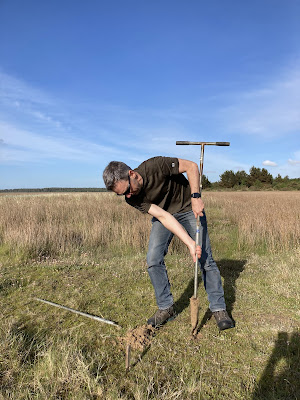In the olden days, we would do our yearly third year field trip in the Taf estuary, where we would take a sediment core (or at least try) that would have interesting things to show, and we would take surface samples to help us find out what it actually was the sediment core was saying.
Last year we had to move the field trip to the Cefni estuary, and we tried to do a similar thing. Some exploratory work suggested that the surface samples were a bit less interesting in this estuary, but we hoped the sediment core, for which we did not do any exploratory work, would be equally interesting. We didn't try because you can't feasibly do that with the percussion corer we use on the day, and we didn't seem to have a hand coring set. But the technical staff were alerted to that, and I sort of assumed that had been sorted.
When we actually were in the field with the students, the core was very dull. A few centimetres of salt marsh sediments at the top, and then sand as far as the eye can see. That's not much we can work with. So we needed to think of somewhere else to go. Luckily, we had noticed that there were several layers of salt marsh sediment outcropping a bit further down the estuary. If these came to the surface, they must also be present in the subsurface. Or at least, that is what you would assume. And I had indicated I wanted to do a recce to try that out. I had asked Martin if he wanted to join me; this didn't look like a good job for just one person. And he did. So one relatively quiet week we made plans to quickly pop into the field after work on a sunny evening.
I knew we didn't have vehicle access, and I also knew how far the location we had in mind was from where we would have to park up. So I was thinking of bringing my big black bike. We might just use that to carry the coring kit, but we could even use it to get to where we needed to be. So I managed to squeeze the big thing into my little car, made sure I had water, a jumper, a jacket, water and some emergency food, a field notebook and something to write with, and a tape measure with me, and then set off to pick Martin up from the office. I had only mentioned the bike that day, when he was already in the office, so he was not in the position to bring a bike himself.
We only had 2 m worth of coring kit. I had thought we would have as much as we could possibly need, but I had taken my eyes off the ball the previous autumn, and no further purchases had been made. But 2 m would do!
I drove us to Newborough Forest and there the fun began. I suggested we would indeed both pile onto the bike, and make our way that way. And we did not have a bag for the coring kit. Martin chose to sit on the back so he was holding that. This meant he was practically holding a jousting lance. It reminded me of the Dutch tradition of 'ringsteken'! That is traditionally done with horses and not bicycles, but hey, a bike is only a steel steed. Quite a lot of dog walkers we came across looked at us in a funny way. And it was a bit bumpy; my tyre could have done with a bit more air, and we were riding on a gravel road, but it was a lot quicker than walking. It sort of worked! Until we hit a sizeable bump and my gear jumped. We decided we would walk the rest.
We tried a few locations. We knew we shouldn't bet on one horse! And even spreading our bets didn't quite yield what we had hoped. Quite soon we had a core where we at least managed to hit one layer of fossil saltmarsh sediment. We made sure we logged the location. We had a few more attempts, but we tended to find just sand. And even when we were coring only about a metre upslope from the four outcropping fossil salt marsh layers, we didn't get anything better. This puzzled us. You could follow these layers along the estuary for some hundred metres! Why did we lose them if we only moved a metre sideways? I tried to track one of them with our pallet knife. I could follow it for about a foot and then it vanished. Why did it do that? How could we have such a continuous layer being gone so quickly on the side where it was protected by the rest of the sediment? We were thoroughly puzzled.
We knew we had the one location that would do for the first year. And we know what we would want to look for in the sediment. That was a start. And we could go further; we might even do a transect with the students during the fieldtrip. No reason why you can't use these extra hands when you have them! And there is absolute didactic merit in involving them in our process of understanding the whole estuary.
We called it a day and walked back to the bike, and then did our jousting exercise again. This estuary is challenging for the sort of things I like to do, either with students or with research. But I am sure we can do something satisfying with it!
 |
| Coring up sand |
No comments:
Post a Comment